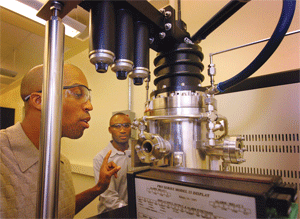Nanotube forest grown on silicon chips promises cooler parts
A team of engineers at Purdue University (West Lafayette, IN) has shown how to grow carbon nanotube forests on the surfaces of computer chips in order to enable the heat flow at a critical point where the chips connect to heat sinks. The carbon nanotubes were grown using a technique called microwave plasma chemical vapor deposition — a low-cost method for manufacturing a thermal-interface material made of carbon nanotubes.

Purdue University’s researchers have shown how to grow forests of carbon nanotubes onto the surfaces of computer chips.
Conventional thermal interface materials include greases, waxes, and a foil made of a metal called indium. All of these materials, however, have drawbacks. For example, the greases don’t last many cycles when testing chips on the assembly line more than once and the indium foil doesn’t make good enough contact for optimum heat transfer.
The Purdue researchers created templates from branching molecules called dendrimers, forming these templates on a silicon surface. Then, metal catalyst particles that are needed to grow the nanotubes were deposited inside cavities between the dendrimer branches. Heat was then applied to the silicon chip, burning away the polymer and leaving behind only the metal catalyst particles.
Then the catalyst particle-laden silicon was placed inside a chamber where it was exposed to methane gas. Microwave energy was applied to break down the methane, which contains carbon. The catalyst particles prompted the nanotubes to assemble from carbon originating in the methane, and the tubes then grew vertically from the surface of the silicon chip.
Because the catalyst particles — made out of transition metals, such as iron, cobalt, nickel, or palladium — are approximately 10 nm in diameter, they allow the formation of tubes of similar diameter. The branching dendrites are tipped with molecules called amines that stick to the silicon surface like handles.
The research has been funded by NASA through the Institute for Nanoelectronics and Computing, based at Purdue’s Discovery Park. For more information, call Baratunde A. Cola at 765-496-8339 or e-mail bcola@purdue.edu.
Christina Nickolas
Advertisement
Learn more about Purdue University





